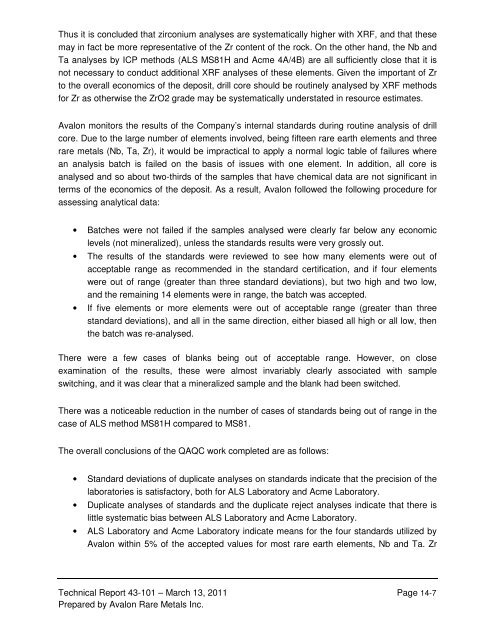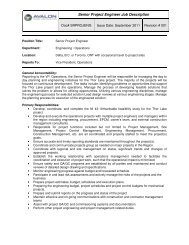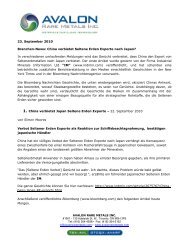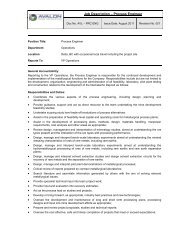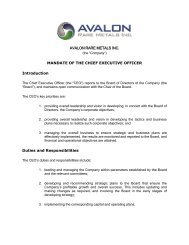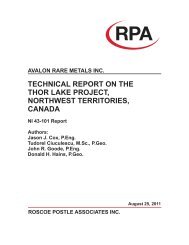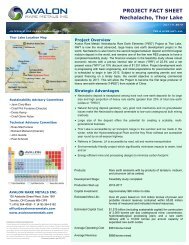technical report on the nechalacho deposit, thor lake project ...
technical report on the nechalacho deposit, thor lake project ...
technical report on the nechalacho deposit, thor lake project ...
Create successful ePaper yourself
Turn your PDF publications into a flip-book with our unique Google optimized e-Paper software.
Thus it is c<strong>on</strong>cluded that zirc<strong>on</strong>ium analyses are systematically higher with XRF, and that <strong>the</strong>se<br />
may in fact be more representative of <strong>the</strong> Zr c<strong>on</strong>tent of <strong>the</strong> rock. On <strong>the</strong> o<strong>the</strong>r hand, <strong>the</strong> Nb and<br />
Ta analyses by ICP methods (ALS MS81H and Acme 4A/4B) are all sufficiently close that it is<br />
not necessary to c<strong>on</strong>duct additi<strong>on</strong>al XRF analyses of <strong>the</strong>se elements. Given <strong>the</strong> important of Zr<br />
to <strong>the</strong> overall ec<strong>on</strong>omics of <strong>the</strong> <strong>deposit</strong>, drill core should be routinely analysed by XRF methods<br />
for Zr as o<strong>the</strong>rwise <strong>the</strong> ZrO2 grade may be systematically understated in resource estimates.<br />
Aval<strong>on</strong> m<strong>on</strong>itors <strong>the</strong> results of <strong>the</strong> Company’s internal standards during routine analysis of drill<br />
core. Due to <strong>the</strong> large number of elements involved, being fifteen rare earth elements and three<br />
rare metals (Nb, Ta, Zr), it would be impractical to apply a normal logic table of failures where<br />
an analysis batch is failed <strong>on</strong> <strong>the</strong> basis of issues with <strong>on</strong>e element. In additi<strong>on</strong>, all core is<br />
analysed and so about two-thirds of <strong>the</strong> samples that have chemical data are not significant in<br />
terms of <strong>the</strong> ec<strong>on</strong>omics of <strong>the</strong> <strong>deposit</strong>. As a result, Aval<strong>on</strong> followed <strong>the</strong> following procedure for<br />
assessing analytical data:<br />
• Batches were not failed if <strong>the</strong> samples analysed were clearly far below any ec<strong>on</strong>omic<br />
levels (not mineralized), unless <strong>the</strong> standards results were very grossly out.<br />
• The results of <strong>the</strong> standards were reviewed to see how many elements were out of<br />
acceptable range as recommended in <strong>the</strong> standard certificati<strong>on</strong>, and if four elements<br />
were out of range (greater than three standard deviati<strong>on</strong>s), but two high and two low,<br />
and <strong>the</strong> remaining 14 elements were in range, <strong>the</strong> batch was accepted.<br />
• If five elements or more elements were out of acceptable range (greater than three<br />
standard deviati<strong>on</strong>s), and all in <strong>the</strong> same directi<strong>on</strong>, ei<strong>the</strong>r biased all high or all low, <strong>the</strong>n<br />
<strong>the</strong> batch was re-analysed.<br />
There were a few cases of blanks being out of acceptable range. However, <strong>on</strong> close<br />
examinati<strong>on</strong> of <strong>the</strong> results, <strong>the</strong>se were almost invariably clearly associated with sample<br />
switching, and it was clear that a mineralized sample and <strong>the</strong> blank had been switched.<br />
There was a noticeable reducti<strong>on</strong> in <strong>the</strong> number of cases of standards being out of range in <strong>the</strong><br />
case of ALS method MS81H compared to MS81.<br />
The overall c<strong>on</strong>clusi<strong>on</strong>s of <strong>the</strong> QAQC work completed are as follows:<br />
• Standard deviati<strong>on</strong>s of duplicate analyses <strong>on</strong> standards indicate that <strong>the</strong> precisi<strong>on</strong> of <strong>the</strong><br />
laboratories is satisfactory, both for ALS Laboratory and Acme Laboratory.<br />
• Duplicate analyses of standards and <strong>the</strong> duplicate reject analyses indicate that <strong>the</strong>re is<br />
little systematic bias between ALS Laboratory and Acme Laboratory.<br />
• ALS Laboratory and Acme Laboratory indicate means for <strong>the</strong> four standards utilized by<br />
Aval<strong>on</strong> within 5% of <strong>the</strong> accepted values for most rare earth elements, Nb and Ta. Zr<br />
Technical Report 43-101 – March 13, 2011 Page 14-7<br />
Prepared by Aval<strong>on</strong> Rare Metals Inc.


